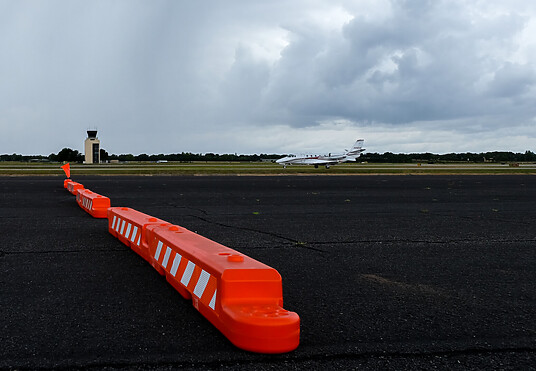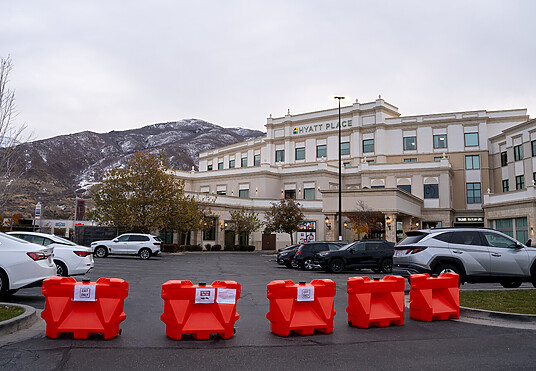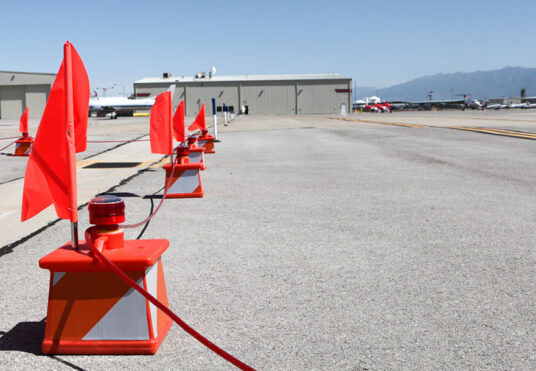The Invention of Low-Profile Airport Barricades
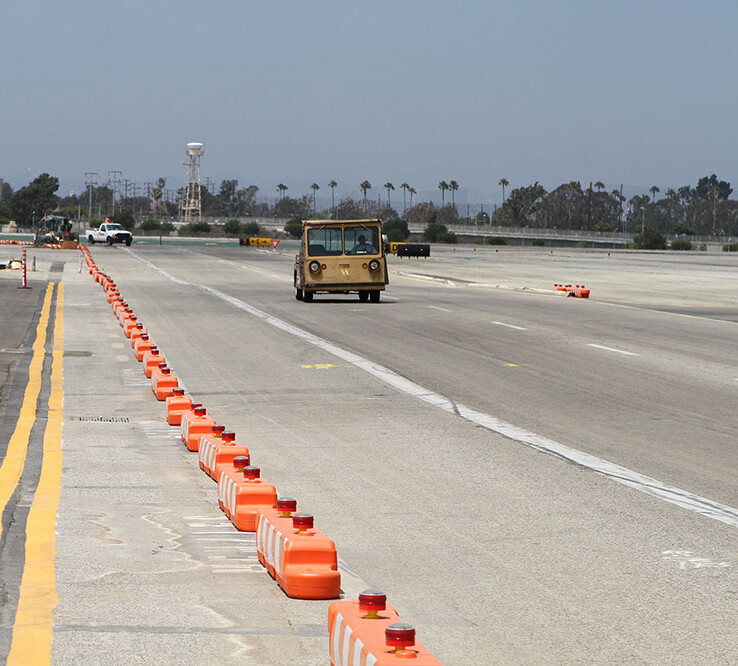
From Railroad Ties to FOD-Free Innovations
Some of the most stressful jobs are those working in air operations areas: constantly moving aircraft, people, and machinery all create an environment where the smallest lapse can have catastrophic consequences.
This is just as true when it comes to construction on these sites. Clearly marked boundaries and carefully managed work areas are crucial to the safety of travelers and workers on an airfield. For a long time, railroad ties—the large wooden beams used to support railroad tracks—were fitted with reflective panels, lights, and sandbags to be used as barricades to mark off construction areas and redirect planes.
Railroad tie barricades were susceptible to weathering, insects, rot, and the hardware used to assemble them along with the sandbags used to weigh them down provided even more opportunities for Foreign Object Debris (FOD) onto the runways and taxiways, creating hazardous conditions. This is in large part why the FAA banned the use of railroad tie barricades by 2003.
Why is FOD a big deal?
Foreign Object Debris (FOD), refers to any item or substance that is not where it is supposed to be. On a runway or taxiway, this could be anything from hardware left behind to rocks, candy wrappers, or even living things like birds or humans.
Some airports go as far as bringing on site birds of prey or blasting distress calls to keep away wildlife from the runways! Unfortunately, these methods don’t work very well when it comes to stray tools or hardware.
Working on an airfield is a lot like working in a surgical room: there are delicate operations, tools must all be accounted for, and something as simple as a rag left behind can have terrible, expensive, and even fatal consequences.
Any of these things can cause damage by blowing out tires at high speeds, getting sucked into a turbojet and shredding fan blades, get caught in equipment and mechanisms, and any of this debris can be blasted out and injure people.
In July 2000, an Air France Concorde crashed soon after taking off due to a tire rupture caused by FOD, which cascaded into a fuel tank rupture and fuel-fed fire [1].
In March 2013, passengers had to be rapidly disembarked from a plane due to smoke and fumes coming from the aircraft’s GPU, caused by what was found to be a small metallic piece of FOD [2].
This type of damage is estimated to cause anywhere from $4 – $13 billion a year [3], not to mention the time, energy, and lives that are also at stake.
Brains over Brawn – Bigger isn’t always better.
Airport operations areas provide unique challenges. Despite the large machinery, bigger and heavier isn’t the simple solution when it comes to choosing barricades.
Low engines and propellers restrict height, pilots sitting high in aircraft make visibility difficult, and on a site where every item that enters the area must be accounted for, materials and assembly become a much more delicate ordeal.
Although railroad ties weren’t banned until 2003, OTW had already brought a new kind of barricade onto the scene — low-profile airport barricades — solving a lot of the problems caused by the old railroad tie barricades, as well as bringing in new innovations that made them easier, more versatile, and safer to use.
The 1999 Original
In 2000, a Boeing 747 crashed and was broken into 3 parts after running into concrete jersey barricades and construction equipment. There were 83 fatalities [4].
Ahead of the curve, OTW Safety founder Marc Christensen patented the first low-profile airport barricade and introduced this safer alternative to the market in 1999. These barricades were manufactured from rotationally-molded plastic, making them easy to mass produce, durable, and reusable. Ballasted with water, these low-profile airport barricades could withstand blasts from jet engines, propellers and extreme weather, but were designed to collapse when impacted by an aircraft, a unique feature that helps prevent these barricades from being an additional hazard themselves. With their durable materials and no need for added sandbags, FOD from construction barricades was greatly reduced.
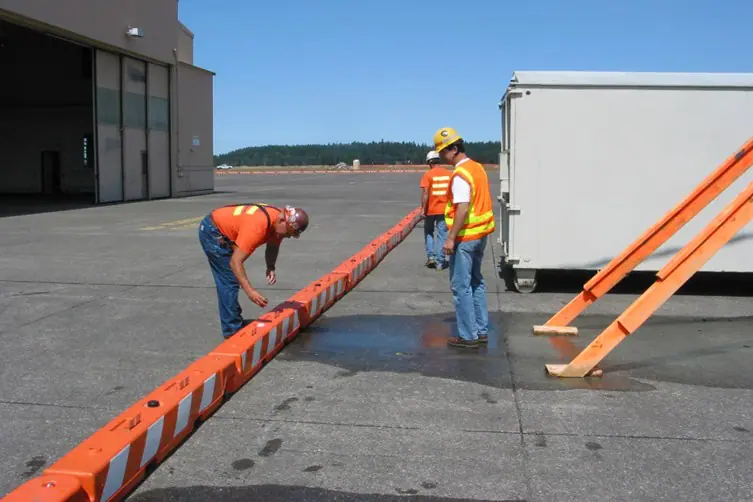
2003 – Orange is the New Barricade
As 2003 arrived and railroad tie barricades left the scene, more airports turned to OTW’s new option, and new innovations were added:
- Height was reduced from 24” to 10”. This made it able to better accommodate low-hanging engines and propellers
- Modifications were made so that flashing warning lights and flags could be attached
- Sides were given a 3 degree angled slope for better visibility for pilots sitting high up in the aircraft
- Design was updated so that a line of barricades could be bolted together
Bring on the New (2004 – Present)
Thanks to years of industry feedback, OTW has been able to continue improving these barricades:
- Utilization of UV-resistant High Density Polyethylene (HDPE), a superior grade of plastic made to resist wear from stress and weather conditions.
- Connection pin is integrated into design which secures low-profile airport barricades together without extra hardware
- Flags are now manufactured with a fiberglass dowel designed to keep it in place, even up against jet blasts
- Reflective sheeting now factory-attached with adhesive, eliminating the use of bolts, further reducing FOD
- Hazard warning lights are solar-powered and fit directly into barricade, eliminating hardware
Trusted by Major Airports Worldwide
The next time you find yourself taking off from airports like Boston or San Francisco, take a peek out the window and you may see some of our low-profile airport barricades in action. From New York’s JFK to LAX in the City of Angels, OTW has worked with hundreds of airports across the U.S. Staying at the forefront of emerging safety standards and technology, OTW is proud to now provide an airport barricade line that is highly visible, FAA-compliant, and 100% FOD-free. As the designer, manufacturer and seller, we have worked hard to exceed FAA requirements and provide airports the safest, most reliable low-profile barricades on the market. Contact us here for more information.
References
[1] “Charles De Gaulle Airport.” Wikipedia, Wikimedia Foundation, 20 Oct. 2019, https://en.wikipedia.org/wiki/Charles_de_Gaulle_Airport. Accessed 10/20/2019.
[2] “SKYbrary Wiki.” E170, Nuremberg Germany, 2013 – SKYbrary Aviation Safety, https://www.skybrary.aero/index.php/E170,_Nuremberg_Germany,_2013. Accessed 10/20/19.
[3] “What Is FOD?” The FOD Control Corporation – A Leading Supplier of Foreign Object Damage or Debris (FOD) Prevention Equipment and Training Materials Worldwide., https://www.fodcontrol.com/what-is-fod/. Accessed 10/20/2019.
[4] “Singapore Airlines Flight 006.” Wikipedia, Wikimedia Foundation, 9 Nov. 2019, https://en.wikipedia.org/wiki/Singapore_Airlines_Flight_006. Accessed 10/20/19

